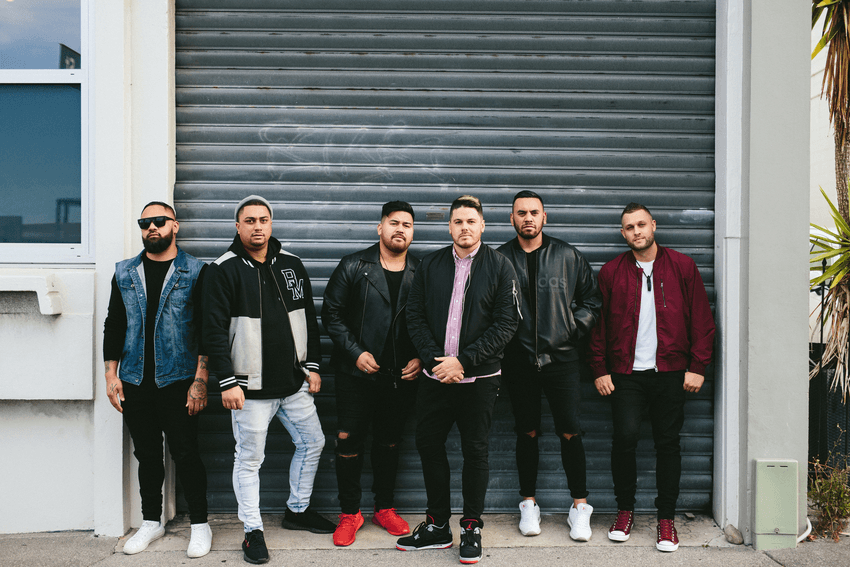After a decade of making music, Sons of Zion are still refusing to settle into a genre. They sit down to talk about the joys of pop music and te reo Māori, and why a “reggae” band can do both.
In 2009 Sons of Zion released their debut album, a self-titled fusion of rock, R&B, and reggae. They still refuse to be tied down to a genre. With their latest releases, earworms ‘Drift Away’ and ‘Come Home’, the six man band has openly acknowledged its pop influences.
“I guess a lot of people would use ‘pop music’ in a negative sense, but we’re pop fans,” says keyboardist Joel Latimer. There’s excited murmuring from the whole group. “We love pop,” they all agree. “We’re big pop fans.”
Latimer expands on the thought. “I think now we feel way more comfortable going all the way there with the music, rather than dialling it back a bit and throwing more reggae flavour in. If we’re gonna make it poppy sounding, then that’s just that moment in time.”
Matt Sadgrove, guitarist and producer, also believes the pop sound comes naturally to the band. “We’re not intentionally writing things to be more pop-radio friendly. We naturally ended up there. We all listen to that music anyway.” Sons of Zion have always been clear about their inspirations: artists like House of Shem, Bob Marley, and Katchafire. But the band has less obvious muses. The group begin listing off artists on their playlists: Khalid, Ed Sheeran, Tears for Fears, the Vengaboys, DuckTales.
These days the band’s playlists include more and more local artists; and so does the top 40. Things have changed for Kiwi musicians since Sons of Zion’s first album. “We wrote and recorded the album at home in the garage and made a living off that to get to where we are now,” recalls Latimer. “But a lot of the new stuff – there are new studios, new producers – there’s a lot that’s really taken New Zealand music up a few notches.”
When making their first EP, the band printed the sleeves themselves and sat in their lounge, sliding in CDs by hand. “It was all crooked,” remembers Rio Panapa. “The printing was ugly and faded.”
Sadgrove believes the digital era has given the New Zealand music industry a much-needed injection of talent. “It’s cheaper to make a record now,” he says. “And New Zealand has always had a freakish number of talented people. That’s why New Zealand’s in such good shape now, I think, because it’s easier to get your stuff out.”
Latimer agrees. “The avenues are easier, so the talent can actually come through.” New Zealand musicians lift each other up in a way that is difficult to find in the international scene. Sons of Zion, Tomorrow People, Drax Project, Katchafire – they’re not just collaborators, they’re friends.
For Te Wiki o Te Reo Māori this year, Sons of Zion will be one of several bands releasing te reo Māori versions of their songs. The album Waiata/Anthems, released on September 6th, will feature a version of ‘Drift Away’ – ‘Pōtere Ana’ – alongside Māori-language versions of hits by artists including Six60, Stan Walker and Bic Runga.
“It was really hard,” says singer Caleb Haapu. “I don’t speak Māori. It was really hard to get the pronunciation right, and when I do something I want to do it all the way, go hard or go home, so that made it even harder.”
“We’re all very proud of our heritage and our culture,” says Sadgrove. “There are little bits of Māori we speak here and there, and we work in Māori music all the time, but it’s definitely something you don’t want to get wrong. Tiki [Taane] was saying it’s the hardest thing he’s ever recorded as well.
“I think everybody’s just trying to do it right. It’s not easy.”
The band has talked about writing in Māori before. “We just don’t want it to be like, contrived, or just doing it for a publicity stunt or something,” explains Sadgrove. “We want it to feel like it’s a song that was meant to be in Māori, for that purpose.”
He goes on to explain that there can be anxiety around using te reo Māori. “In the Māori world, there are all these stories about getting torn down for doing it wrong,” he says. Ross Nansen, the drummer, chimes in. “There’s a lot of fear about the reo police!” The group laughs, and talks about how things are changing. “People like Rei – he’s been using it seamlessly from the start,” Sadgrove says. “And Drax Project, to have them on Waiata is great, for me.” Drax Project is a predominantly Pākehā band, and features on the album with a te reo Māori cover of ‘Woke Up Late’ (‘I Moeroa’).
Panapa has been out at Ihumātao lately, and felt the kaupapa there was similar. “It was cool to be part of something that, I think, is big for our generation and our time,” he says. “I went to have a look around and as soon as I got there I saw my mates on the barbecues, so got roped in to some cooking,” he laughs. “I met some cool people. We can say we were there, we stood up and we were counted.”
Sons of Zion count. The band is a driving force of the New Zealand music industry, of Māori music, and of countless fans’ emotional recovery. “I always remember that one lady in Christchurch, whose husband had passed away,” says Sadgrove. “Their wedding song was ‘Tell Her’ and she wanted a photo with Rio, because that was her connection to her husband. Those moments are really cool.”
This piece was made with support from NZ on Air.
